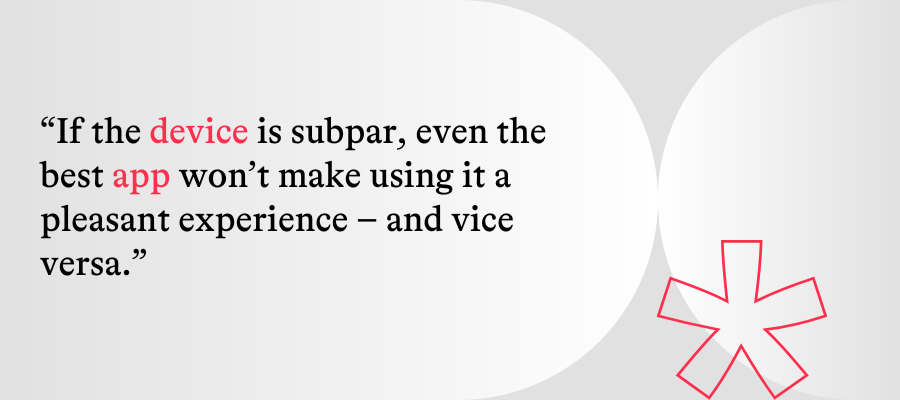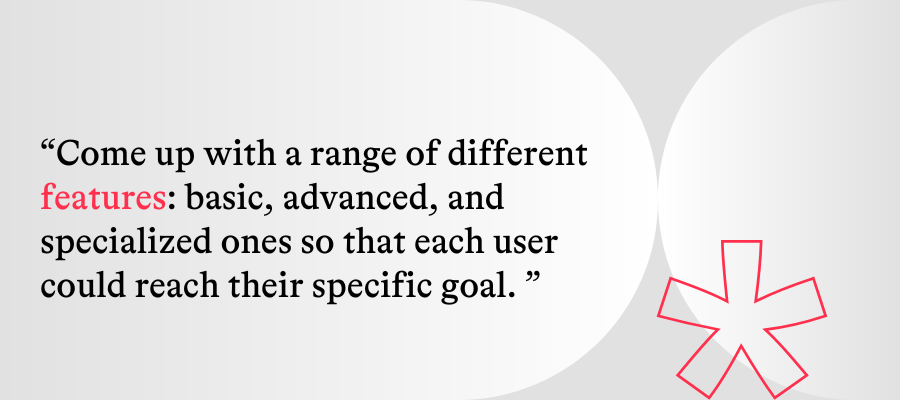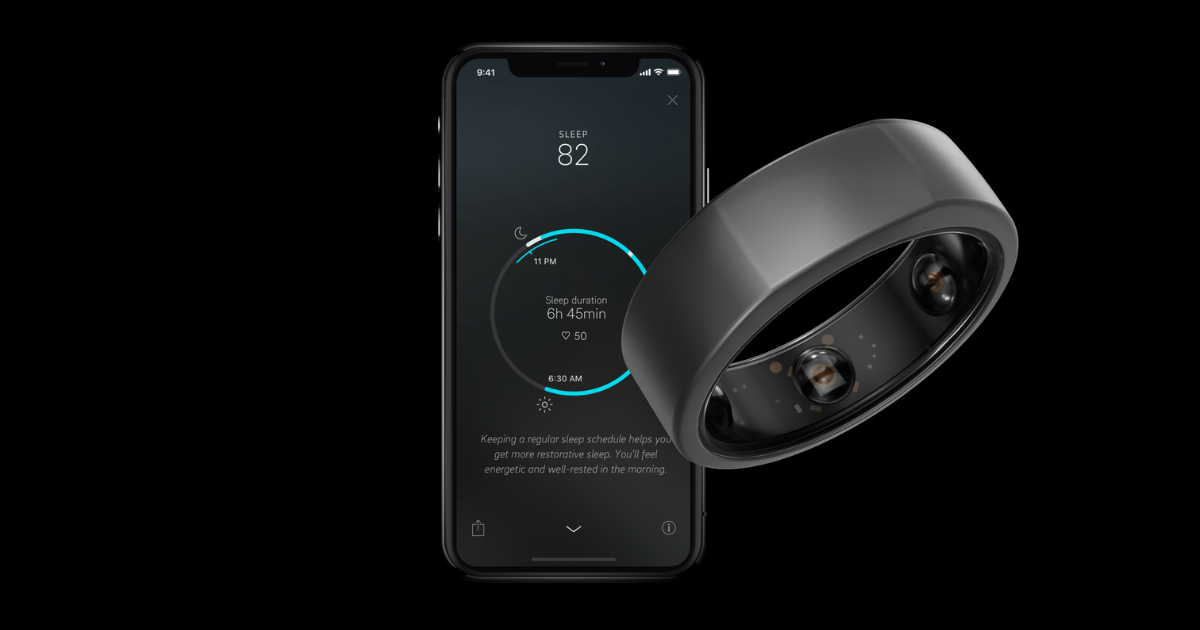The role of mobile apps for IoT devices is often underestimated. While the physical product may capture most of the attention, it’s the app that serves as the primary point of contact with the device for users, offering a crucial interface for interaction.
This article delves into the significance of IoT apps, their impact on user satisfaction, and the importance of viewing the app and the device as a single product. Let’s get started!
The app and the device as one product
Product companies may think of the app as an addition (or a ‘companion’, as it’s often called) to their device – but this is not how the users see it.
The truth is that, depending on the kind of IoT device, the app is probably the most important touchpoint for it. Lots of devices – like wearables, smart trackers, or smart rings – don’t have a physical interface, and it’s simply not possible to interact with them without an app.
How the users perceive it

Having that in mind, what’s important to understand is that your customers experience and asses your hardware and app as one. If the device is subpar, even the best app won’t make using it pleasant, and vice versa; if the product is superb but the app offers an inferior experience, people’s satisfaction with it will drop.
It’s not a question of whether the app is more important, or the device. This becomes obvious when browsing both app and product reviews. During pre-purchase research, people check product reviews and app reviews and seek social proof (buyer reviews); the more expensive the purchase, the more thorough the research.

They tend to mostly leave extreme ones (either a 1 or 5 rating) as it is the easiest to elicit a reaction when someone is either very pleased or very disappointed. So when checking Amazon for reviews of physical devices, you are guaranteed to find loads of comments about the app.
Conversely, if you check the App Store or Google Play Store, you will find opinions about the device. This directly affects sales – when people see bad reviews, they simply won’t buy your product, and it won’t matter if it’s the device or the app that is the problem.
Remember: the physical part and digital parts are intermingled, they very much affect each other and you need to think about it as a whole – because that’s how your users see it.
Providing value

A crucial aspect to think of when creating an IoT app is providing actual value to the people using your product. When creating your app, it’s critical to learn what the value is and communicate it appropriately.
One way to do it is to provide users with insights they wouldn’t get from the device itself. If, for example, it is a tracker device, all the hardware itself does is provide data, which in and of itself isn’t very important to the users. The way the app can provide value here is through data aggregation and insights like historic values, trends, and comparisons.
For example, if a person is using a smartwatch that can check their heart rate, then the number itself won’t be that important to them. However, if they are given the possibility to compare how their heart rate behaves during the day, week, or month, then they can learn more about their health and take care of it better. This is something that only the app, and not the device itself, can do.
Communicating with customers

Your app serves as a way to directly reach your users. First of all, you can use it to inform about new features, updates, and promotions – but be careful not to abuse it and annoy customers in the process.
On the other hand, you can use the app as a source of information for your customers and to gain feedback. You can ask questions through the app and implement analytics to see how the users behave – how they use the app, what they tap, which features they’re using, what presets are the most popular, and much more.
Ensuring the product is accessible to various types of users
Personalized experience

When creating a product, different user groups that are going to use it need to be thought of, as well as their needs, and how to answer those needs. This is where the app helps immensely. The key is to think about a range of different features: basic, advanced, and specialized ones so that each user could reach 100% of their goal.

Take a simple sports tracker as an example. A ‘basic’ user that’s not really physically active will probably select low goals, and the app should adjust to their preferences. On the other hand, a professional athlete with much higher goals needs to be able to set and complete them – even if they are unattainable to most regular users.
It’s all about striking the balance between the experience being personalized for the person who uses the device and leaving room for different kinds of goals that other kinds of users might be interested in.
Different levels of technical expertise

When creating the app for your device, keep in mind that there are a lot of limitations and obstacles caused by the technology itself. And while more technical-savvy users will learn to understand and accept them, people without that knowledge won’t.
The best way to illustrate this issue is through the example of Android’s requirement to access the user’s location in order to connect to Bluetooth devices. If an app asks for location permission (and it’s a very distinct pop-up on the interface), people may not understand why they need to give the app permission if all they want is to, for example, connect to their printer.
What’s needed here is clear information: the location is not collected and it isn’t stored, but because of the OS, the app needs to ask for it. For people that are well versed with technology, granting that permission is pretty obvious, but for those who are not, it’s pretty confusing and induces privacy concerns. It’s important to anticipate the places where people may feel uncomfortable or anxious and act accordingly by informing and educating.
The app as a competitive advantage
While we have talked about the importance of providing value to the users, you need to verify your assumptions as early as possible. Making your device ‘smart’ by adding an app just for the sake of it is simply not enough, and many products fail spectacularly for this very reason (like the infamous 699$ juice squeezer that would only pour juice once connected to Wi-Fi).
There needs to be actual value added for the product to be connected. A lot of startups come up with their product idea based on a single observation, and it’s simply not enough to justify building a connected device around it. This is where user research comes in – there needs to be a verification of the problem, and the problem needs to exist among at least part of the population.
Test your ideas. Take your wireframes and reach out to prospective users and see how they like it, how they use it, and what they have problems with. Once you know that, you’ll be able to validate your product, iterate, and make it better.
Conclusion
When creating an app for a connected device, the most vital thing is to remember that the users will view the device and the app as a single product.
What people tend to remember from an activity is the most intense experience and the ending. What delivers said experience – whether it’s an app or the device itself – won’t really matter to customers. Make sure the app is actually useful to the users, that it provides them with additional value, and capitalize on the possibility to communicate with the users through the app to make your product better.
Looking to start or improve your IoT project? Don’t hesitate to contact us; we specialize in app development for connected devices.

Piotr Schmidtke
UX Expert

